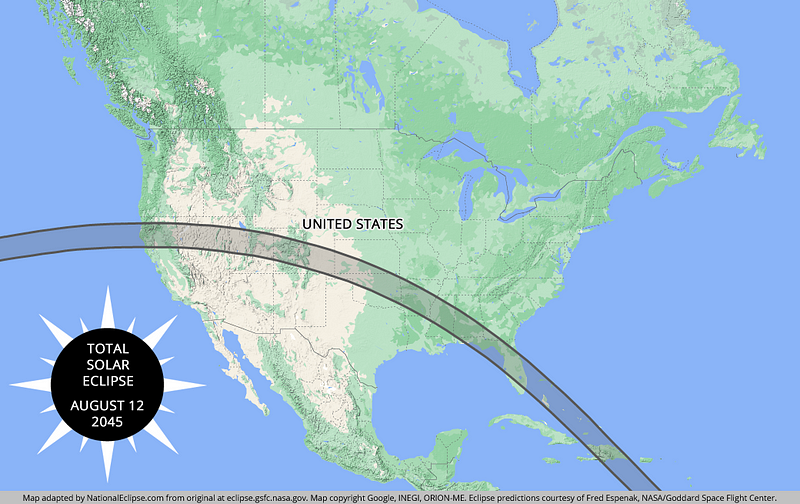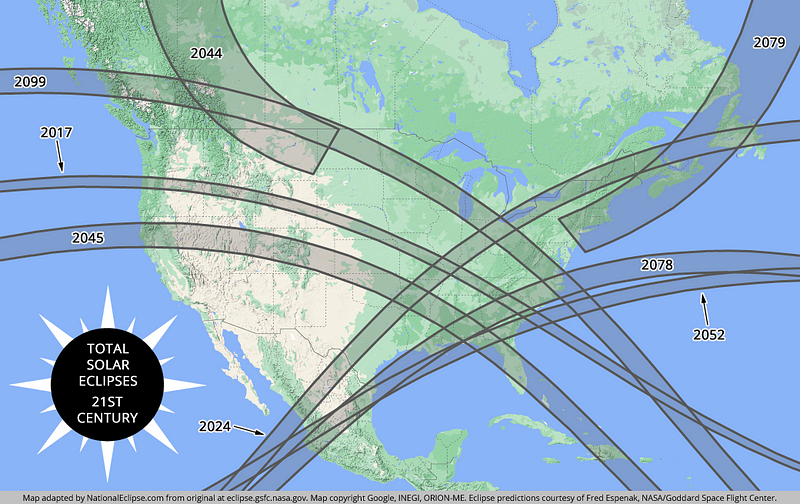The Fascinating Mathematics Behind Total Solar Eclipses
Written on
Chapter 1: The Marvel of Total Solar Eclipses
Total solar eclipses are extraordinary natural events that draw significant attention. It's anticipated that around 5 million Americans will embark on a journey to witness the upcoming eclipse along the "path of totality." This particular solar eclipse is noteworthy as it traverses one of the most densely populated regions in the Western Hemisphere. However, total solar eclipses, in general, are not as uncommon as they might seem.
Solar and lunar eclipses occur frequently, but the rarity lies in their visibility from accessible locations. Due to vast uninhabitable areas, such as Antarctica and the oceans, it’s quite uncommon for an eclipse to be observable from populated regions. Tens of millions of individuals across the U.S. can reach this path of totality within a few hours—a truly rare opportunity.
What makes these solar eclipses captivating isn’t just the breathtaking sight of the sun being obscured for a fleeting moment, but the fact that they occur at all. The underlying mathematics is what makes them particularly intriguing. Even as someone who typically dislikes math, the calculations involved in solar eclipses are enough to spark my curiosity.
The first video explores the fascinating mathematical underpinnings of solar eclipses, particularly the Saros cycle, which is crucial for predicting these events.
Section 1.1: The Unlikely Alignment
Total solar eclipses should, by all logic, be improbable events. For one to happen, certain mathematical alignments must be perfect. During these occurrences, a fortunate few million will gaze upwards to witness the darkened sky at midday, while the rest of us can appreciate the complex mathematics that made it possible.
Subsection 1.1.1: The Size and Distance Proportions
The moon is significantly smaller than the sun, yet it can completely obscure it during an eclipse. This phenomenon is a result of precise mathematical ratios. The average distance between the Earth and the Sun is approximately 93 million miles, though it can vary slightly throughout the year. During its farthest point (Aphelion), Earth is about 94.5 million miles away, while it is about 91.5 million miles away at its closest (Perihelion). These distances average out to 93 million miles.
Conversely, the moon is about 239,000 miles from Earth. This indicates that the Sun is about 389 times farther away from Earth than the Moon. The diameter of the sun is around 865,370 miles, compared to the moon's diameter of approximately 2,160 miles. This means the sun is roughly 400 times larger than the moon, aligning almost perfectly with the distance proportions (389 vs. 400).
If these ratios were not so closely matched, the moon would either fail to block out the sun entirely or would completely cover it, eliminating the stunning corona that dazzles viewers during an eclipse.
Section 1.2: Rarity in the Cosmos
The extraordinary alignment of these celestial bodies seems improbable. While it’s impossible to calculate the exact odds of such a rare coincidence, it suggests that Earth may be quite unique in the vastness of space.
Few planets possess moons that are proportionately comparable in size to their host planets. The existence of Earth’s substantial moon, which orbits at a distance that harmonizes with the sun's distance, is remarkable. This alignment results in the spectacular event of a total solar eclipse.
Chapter 2: The Future of Solar Eclipses
The second video provides essential information about the total solar eclipse occurring on April 8, 2024, detailing what observers can expect during this astronomical event.
In conclusion, while solar eclipses may not be a rarity on Earth, they could indeed be quite exceptional when considering the universe as a whole.

The next solar eclipse to impact North America will take place in 2044, but only in parts of Alaska. The next major total eclipse to cross the contiguous United States will occur in 2045. If luck permits, I hope to experience that one from my home state of Florida. Solar eclipses follow a predictable pattern, allowing us to calculate their occurrence with precision. However, understanding the mathematical ratios that facilitate these phenomena is equally captivating as the visual display itself.
For a look at upcoming solar eclipses in the United States, check out the map below.

